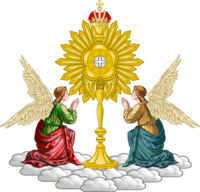
Back Església Mariavita Catalan Mariavitismus Czech Mariavitismus German Mariavitismo Esperanto Église mariavite French Mariavitismo Italian Marijavitai Lithuanian Mariawityzm Polish Мариавитская церковь Russian Mariavitizmus Slovak
This article needs additional citations for verification. (October 2008) |
| Old Catholic Mariavite Church | |
|---|---|
 Mariavite emblem | |
| Classification | Independent Catholic |
| Orientation | Old Catholicism |
| Theology | Mariavitism |
| Polity | Episcopal |
| Prime bishop | Jarosław Maria Jan Opala |
| Associations | World Council of Churches Conference of European Churches Polish Ecumenical Council |
| Region | Poland and France |
| Headquarters | Płock, Poland[1] |
| Founder | Maria Franciszka Kozłowska |
| Origin | 1906 Płock, Poland |
| Separated from | Roman Catholic church |
| Separations | Catholic Mariavite Church |
| Congregations | 44 parishes (2011)[1] |
| Members | 23,436 in Poland (2011),[1] |
| Ministers | 4 bishops; 25 priests |
| Other name(s) | Old Catholic Church of the Mariavites |
| Official website | mariawita |
The Old Catholic Mariavite Church refers to one of two independent Christian churches, both of which can be dated from 1906 but which became distinct after 1935 as a result of doctrinal differences, and are collectively known as Mariavites. Mariavitism first emerged from the religious inspiration of Polish noblewoman and nun Feliksa Kozłowska (1862–1921) living in the Russian Partition of Poland in the late 19th-century. A young Catholic priest from a modest background, Jan Maria Michał Kowalski (1871–1942), became convinced by Kozłowska's revelations and adopted her vision as his own project by her side.
The movement represented an ideology whose aim was to imitate the simplicity of the life of Mary, in Latin, qui Mariae vitam imitantur, ("Let them imitate the Life of Mary"), thus vita Mariae, the Life of Mary, gave the movement its name. The movement became the subject of two Papal bulls in 1906 which resulted in the mass excommunication from the Catholic Church of both clergy and lay adherents to the movement.
The leaders of the movement sought theological sanctuary with the Old Catholic Church of the Netherlands which, after negotiations welcomed them and in 1909 granted both recognition and Apostolic succession to what by default had become a new catholic church, the "Mariavite Church", with the power to confer holy orders. It therefore became a separate and independent religious denomination in Poland.[2] It continued as a unitary church until 1935 when a faction led by bishop Filip Feldman challenged the church leader, Michał Kowalski, and successfully expelled him and his loyalists from the headquarters in the Polish city of Płock, thereby creating two Mariavite churches.
- ^ a b c Poland 2013, p. 44.
- ^ Karski 2003, p. 402.